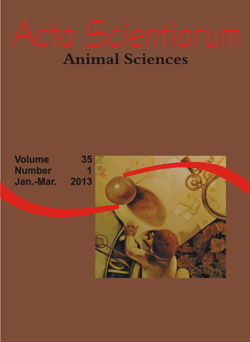<b>Digestibilidade da polpa cítrica desidratada e efeito de sua inclusão na dieta sobre o desempenho de coelhos em crescimento</b> - doi: 10.4025/actascianimsci.v35i1.12359
Resumo
Conduziram-se experimentos para determinar a digestibilidade da polpa cítrica desidratada (PCD) e avaliá-la na alimentação de coelhos. Para o ensaio de digestibilidade utilizaram-se 30 coelhos recebendo duas dietas: uma referência e outra com substituição de 20% da primeira por PCD. O ensaio teve duração de dez dias para adaptação mais quatro para coleta de fezes. Os coeficientes de digestibilidade e os nutrientes digestíveis para MS, PB, FDN, FDA e EB da PCD foram respectivamente: 83,75 e 76,04%; 70,12 e 5,03%; 40,14 e 9,52%; 68,98 e 15,09%; e 81,48% e 3394 kcalED kg-1 MS. Para o desempenho utilizaram-se 120 coelhos recebendo dietas com diferentes níveis de PCD (0, 20, 40, 60, 80 e 100%) substituindo o milho. Observou-se redução linear (p < 0,01) para o consumo de ração e ganho de peso diário, peso vivo aos 50 e 70 dias e rendimento de carcaça com o aumento gradativo de PCD. Efeitos quadráticos (p < 0,01) sobre a conversão alimentar dos 32 aos 50 e 32 aos 70 dias de idade provocaram melhores valores com 42,74 e 44,40% de PCD, respectivamente. PCD a 20% não afetou (p > 0,05) nenhuma característica de desempenho quando comparada à dieta controle. Conclui-se: a PCD pode substituir o milho até 20% nas dietas de coelhos.
Downloads
DECLARAÇÃO DE ORIGINALIDADE E DIREITOS AUTORAIS
Declaro que o presente artigo é original, não tendo sido submetido à publicação em qualquer outro periódico nacional ou internacional, quer seja em parte ou em sua totalidade.
Os direitos autorais pertencem exclusivamente aos autores. Os direitos de licenciamento utilizados pelo periódico é a licença Creative Commons Attribution 4.0 (CC BY 4.0): são permitidos o compartilhamento (cópia e distribuição do material em qualqer meio ou formato) e adaptação (remix, transformação e criação de material a partir do conteúdo assim licenciado para quaisquer fins, inclusive comerciais.
Recomenda-se a leitura desse link para maiores informações sobre o tema: fornecimento de créditos e referências de forma correta, entre outros detalhes cruciais para uso adequado do material licenciado.








































